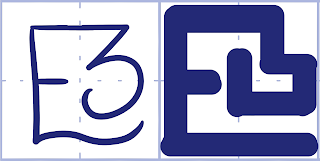Derived Glyphs
There are 36 derived glyphs in Majok. Each glyph is derived from a base glyph, and has a similar meaning. The derived glyphs can represent one idea or a group of similar ideas, but do not represent a sound.
Derivation
Glyphs created by adding a line or changing a curl into a circle tend to be more abstractly / loosely / vaguely related to the base glyph in terms of meaning, whereas the glyphs derived using some combination of wishorim "similar to" and toma "not" (see the Shortened Words lesson) are slightly closer to the original meaning (Note that the ones listed here are no longer considered a combination of the base glyph and shortened word, but rather are now single glyphs).Close-Up and Block Print
 |
| Asud: spring (season) |
 |
| Usod: summer |
 |
| Olim: weather |
 |
| Izeg: autumn |
 |
| Egar: winter |
 |
| Tusir: big / long / more |
 |
| Suchem: she / her |
 |
| Tolej: lose |
 |
| Lomag: win |
 |
| Mihak: I / me |
 |
| Tomihak: you |
 |
| Misak: knowledge/ know |
 |
| Jikup: now, (the) present |
 |
| Jirim: (to) start, (the) start |
 |
| Khekun: small / short / less |
 |
| Gepom: hot |
 |
| Banil: cold |
 |
| Napah: he / him |
 |
| Nabak: move |
 |
| Buluts: destroy |
 |
| Bushuts: empty / disassemble |
 |
| Puluz: till / to |
 |
| Pushuz: about / in terms of |
 |
| Lohok: create |
 |
| Loshok: full / (to) build |
 |
| Rohoch: from |
 |
| Hiwis: demon / devil / evil |
 |
| Hisis: down |
 |
| Wesed: deity / god / good (as in good vs. evil) |
 |
| Weses: up |
 |
| Chirim: (to) end / (the) end |
 |
| Tochirim: still (as in "I'm still reading") |
 |
| Chisek: the future |
 |
| Chisem: after / next |
 |
| Tochisek: the past |
 |
| Tochisem: before / previous |



Comments
Post a Comment